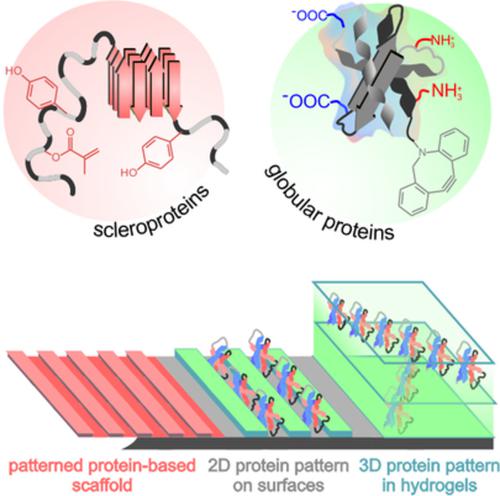当前位置:
X-MOL 学术
›
Biopolymers
›
论文详情
Our official English website, www.x-mol.net, welcomes your feedback! (Note: you will need to create a separate account there.)
Patterning of protein‐based materials
Biopolymers ( IF 2.9 ) Pub Date : 2020-12-07 , DOI: 10.1002/bip.23412 Martin Humenik 1 , Anika Winkler 1 , Thomas Scheibel 1, 2, 3, 4, 5
Biopolymers ( IF 2.9 ) Pub Date : 2020-12-07 , DOI: 10.1002/bip.23412 Martin Humenik 1 , Anika Winkler 1 , Thomas Scheibel 1, 2, 3, 4, 5
Affiliation

|
Micro- and nanopatterning of proteins on surfaces allows to develop for example high-throughput biosensors in biomedical diagnostics and in general advances the understanding of cell-material interactions in tissue engineering. Today, many techniques are available to generate protein pattern, ranging from technically simple ones, such as micro-contact printing, to highly tunable optical lithography or even technically sophisticated scanning probe lithography. Here, one focus is on the progress made in the development of protein-based materials as positive or negative photoresists allowing micro- to nanostructured scaffolds for biocompatible photonic, electronic and tissue engineering applications. The second one is on approaches, which allow a controlled spatiotemporal positioning of a single protein on surfaces, enabled by the recent developments in immobilization techniques coherent with the sensitive nature of proteins, defined protein orientation and maintenance of the protein activity at interfaces. The third one is on progress in photolithography-based methods, which allow to control the formation of protein-repellant/adhesive polymer brushes.
中文翻译:

基于蛋白质的材料的图案化
表面上蛋白质的微米和纳米图案化允许开发例如生物医学诊断中的高通量生物传感器,并且通常促进对组织工程中细胞-材料相互作用的理解。今天,有许多技术可用于生成蛋白质图案,从技术简单的技术(如微接触印刷)到高度可调的光学光刻,甚至技术上复杂的扫描探针光刻。在这里,一个重点是开发基于蛋白质的材料作为正性或负性光刻胶的进展,允许微米到纳米结构的支架用于生物相容性光子、电子和组织工程应用。第二个是关于方法,它允许单个蛋白质在表面上的受控时空定位,固定化技术的最新发展与蛋白质的敏感性、确定的蛋白质方向和界面处蛋白质活性的保持一致。第三个是基于光刻的方法的进展,该方法允许控制蛋白质排斥剂/粘合剂聚合物刷的形成。
更新日期:2020-12-07
中文翻译:

基于蛋白质的材料的图案化
表面上蛋白质的微米和纳米图案化允许开发例如生物医学诊断中的高通量生物传感器,并且通常促进对组织工程中细胞-材料相互作用的理解。今天,有许多技术可用于生成蛋白质图案,从技术简单的技术(如微接触印刷)到高度可调的光学光刻,甚至技术上复杂的扫描探针光刻。在这里,一个重点是开发基于蛋白质的材料作为正性或负性光刻胶的进展,允许微米到纳米结构的支架用于生物相容性光子、电子和组织工程应用。第二个是关于方法,它允许单个蛋白质在表面上的受控时空定位,固定化技术的最新发展与蛋白质的敏感性、确定的蛋白质方向和界面处蛋白质活性的保持一致。第三个是基于光刻的方法的进展,该方法允许控制蛋白质排斥剂/粘合剂聚合物刷的形成。



























 京公网安备 11010802027423号
京公网安备 11010802027423号